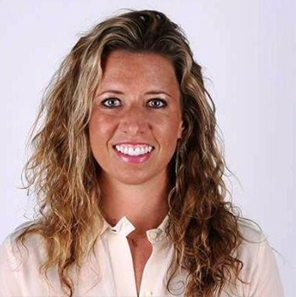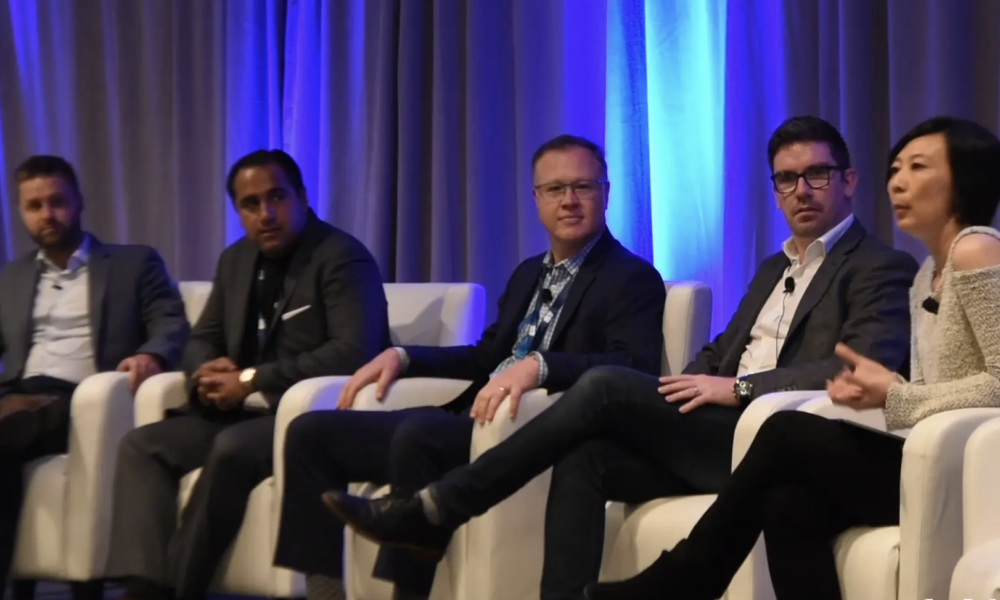Metrics That Drive Bad Sales Behavior
3K Views | 56 Min Read
Jack Kosakowski: Thanks for joining us. So we kind of want to make this a little bit fun, because I think the most exciting thing in sales is to make fun of salespeople, right? Because we do a lot of dumb things. But we’ve got awesome brands here, Outreach, Node.io, Lucid Chart, Slack, and Fastly. I’m going to start by just going this way and letting these practitioners talk, which I think is what’s great. You’re going to hear people that are actually practitioners that are doing exactly what you are doing and they are going to be able to give you their insights. So I’m going to start with you.
Emily Garza: Alright, so I am Emily Garza. I have a background in direct sales, both inside and outside. I then moved over to Fastly about three years ago to start the enablement function there. I did that for about a year and a half and then launched our customer success function.
Andrew Mewborn: I’m Andrew Mewborn, I actually have a background in electrical engineering and I saw this small startup over in Seattle with 20 people about three years ago and said, “I need to get me a piece of that.” So now I’m at Outreach, and it’s a pleasure to be here with all of you.
Gregory McBeth: I’m a reformed engineer as well. So kudos. I work at Node.io. I run sales and marketing. We’re focused on customer and talent acquisition.
Gabe Villamizar: How’s it going? I’m Gabe Villamizar. Can you guys hear me okay? I’m the head of B2B marketing at Lucidchart. Most recently, last week, I transitioned into a new role of global sales evangelist. What does that mean? I don’t know, it sounds fancy. But, I’m glad to be here. I started in the early days of insidesales.com, helped build that in 2012-2013, transitioned to HireVue and was there for a few years, and I’ve been at Lucidchart for two years. So, I’m excited to be here.
Nikki Curtis: Hi, I’m Nikki Curtis, I run enablement at Slack. I’ve been there for about nine months now. Before that I was at LinkedIn for about six years, running our ad sales enablement business. I would say I’m not a reformed engineer, I’m a reformed non-profit worker, so very different background but I’m excited to be here with you guys.
JK: So, we’re going to go into a few different directions. I think we’re going to start off in a little bit fun. So, I want to hear your stories, a story about bad sales behavior that you’ve seen, or one of the worst stories. I’m going to start with you.
AM: You’re going to start with me? Alright, let’s do it. So, a good one we have, as we’ve grown throughout the years, is communication becomes very important. One issue we had is we had our account executives – for my account executive friends in the room, no hard feelings – but they were throwing our solution consultants or our sales engineers on calls with no preparation at all, so we would come in just blind. This isn’t really metrics related, but we said, “how are we going to figure this out?” And so we came up with what we call “SWDDAM”. Does anyone know what “SWDDAM” means? It means “Shit We Don’t Do Anymore”. So our metric, it’s very binary.
JK: But we need one of those stories. We need the story of the shit you don’t do anymore.
AM: So, don’t add SC’s or sales engineers to calls without giving them preparation. That’s the moral of the story on that one.
JK: Perfect. Any more?
GM: I guess there’s the modern, all-time worst example of Wells Fargo. Opening people’s accounts without permission, right, trying to hit particular sales targets. I mean, I’ve been a Wells Fargo customer for a while. I got married, and all of a sudden these spurious accounts showed up when I’d go login. I was wondering where they came from. I figured they came from my wife merging those over from her personal account and kind of just let it sit for a while and then all of the news came out and then suddenly those things just all disappeared. But I think it’s a great, very sad, example of what can happen when you’re really trying to optimize for something that ultimately doesn’t improve the outcome for your customers or for your business.
JK: Anybody else?
GV: I’ve been with a few sales teams that have heard of the term “social selling”. A sales manager tells them, “hey, you should spend a lot of time on LinkedIn and Twitter” without much direction, or maybe they read a blog post about it. The next thing you know, sales reps are just spending hours every week doing random social media or social selling which gets them nowhere. So next thing you know, you have CEOs walking by and everybody’s on Twitter and LinkedIn and stuff like that, and it’s like, okay that’s not the best thing to be on and the screen that you want to be at – especially if the leadership and the management did not give specific instructions or direction. So, just be careful when introducing social selling.
JK: I think the hardest part about this – because this overarching conversation can go anywhere, metrics that drive bad sales behavior – is if I’m a sales manager, sales leader, or account executive right now, there are so many things going on. There are so many channels that I should be on, I should be doing this, I should be doing that. And now we’re in this age of personalization which makes this even harder, right? So, I don’t truly believe that any sales organization has the same exact metrics. It just doesn’t work like that. We all have different buyers, we all sell a different way, on different channels. But how do you determine good metrics and bad metrics for your organization? Where do you start? When you’re essentially building a sales process for your sales reps, how do you know what is important and what’s not? I should do cold-calling, not do cold-calling, social selling, cold emails. How do I know that? Where do you even start?
EG: I can take that one. I’ll start maybe with an example. When I was a young seller, I was not hitting my number, and my manager’s solution was to go say, “Do more. Go get more appointments”. And that really looks at the metrics in a really singular view. The problem could have been that I needed more appointments, but it also could have been that while I was on the appointments, I wasn’t able to do discovery well. I couldn’t propose our solutions. There’s a lot of other pieces of that, and looking at a metric in singularity really didn’t help that. So I think overall as a guideline when we’re looking to set up metrics for sellers is beginning with the end in mind. So understanding, what is that ultimate goal for the seller? Sometimes it’s quota, sometimes it’s 150% of quota. You don’t want to limit them to only hit quota, I’d always encourage them to go above that. And then understanding, what are those different factors that drive there? So, being able to customize it on a per rep basis. What’s their close rate? What’s their average deal size? How many proposals do they need to make in order to get to that close rate? You can start to drill back to all of the different factors that lead into that ultimate goal, and that allows you to craft on an individual basis what each person’s metrics should be.
JK: Yeah. You said on an individual basis. I think this is a tough thing because most sales organizations, and don’t raise your hand if you’re guilty because I can guarantee 80% would, you think it’s a certain amount of calls and you have a lot of sales reps doing the same exact activities or metrics, right? You try to standardize across the board. What she said was individuality. That makes this even harder, right? Now, not only do we have to build metrics for our sales team, but we have to individually build different metrics for different salespeople because they work better that way. I want to get somebody’s input on that and how do you overcome that?
NC: Yeah, I’ll talk a little bit about what we’re doing at Slack right now because we’re starting from scratch where we don’t really have any data, we don’t have the metrics, we don’t have the infrastructure. So I’m actually trying to start more of a broad sweep across. So rather, we’re not at the stage yet where we’re doing individuals, we’re actually doing it by segment. What does it look like for our large enterprise, what does it look like for our enterprise, and what does it look like for our mid-market? I actually think exactly to Emily’s point, it’s really about, what’s your north star, where do we need to get to? What’s our lagging indicator and what are the leading behavioral indicators that we can actually start to track and measure? I also think it doesn’t stay static.
I would say last year at Slack, we had all this low-hanging fruit of all these leads coming in and now we’re in an evolution of the industry where we’re actually having to go out and do more prospecting. So now we actually have to create more metrics around what does good prospecting look like? And it’s not really, to me, on an individual basis. It’s actually saying, “hey, if we need to hit our annual targets, we need to be at 2X in pipe gen.” And so what do we actually need to do as an organization to get to 2X pipe gen to hit that ultimate target. I rely a lot on where we are trying to get to, and then you work backward on what the things are you can influence. And you can’t do it all, so I usually pick our top two and three with an educated guess on what we really think is going to make the most amount of impact. And then you continue to reevaluate that quarter over quarter, maybe year over year. We’re at the stage where it’s definitely quarter over quarter right now because we’re just building these arms from scratch right now.
GV: Yeah, so something along the same lines of beginning with the end in mind. So, Rob Jeppsen, he’s a sales coaching legend and founder and CEO of Exvoyent…
JK: Did you hear that, Rob?
GV: Is Rob in the room? So what he kind of preaches and lives is, what’s the outcome that you want? What’s the end goal? And you want four things that are made up of those. Number one, you need stages. So the CSON site says if you have more than six stages in your sales cycle, then you’re not predictable. So if you want outcomes, then you need stages. Stages then are made up of activities. What are those activities within each stage that’s going to move the deal forward? After you have those activities, then you need skills to do those activities. And then those skills then are made up of resources. Okay, so if you have those four things, then you should have an outcome and you need to have metrics for each four of those. Again, if you want outcomes, then you need stages. Then stages are made up of activities, activities of skills, and skills of resources.
JK: Okay, let’s dive into this. I’m not going to do any product plugs, but Outreach, this is what you guys help manage, right? So, you guys all hear the cadence. Is anybody here practicing cadences with their salespeople? So you’re tracking all of that, we have technology for that. Let’s break into the metrics of that. What do you guys see in working with your customers and your internal sales team? What metrics are included in this to get to the outcome that you see are the top three to five having the most impact?
AM: Definitely. So the way I look at it, and Mark Cosogow if any of you know him, he coined the term called “lit”, I like to say. You have your leading metrics, you have your indicating metrics, and then you have your trailing metrics. So, at the end of the day, we all want to measure how many opportunities our reps creating, how many meetings these reps are creating. But in order to get to that point, it’s very important, but you have to get to the beginning. What are they doing to get there? And how do we break it down into a simple metric so that reps understand what it is they need to do because if you throw 10 or 20 metrics at these folks, it’s like “okay, where do I focus?” So, we try to keep it very simple whether using Outreach, Sales, any cadence tools. What does a rep need to know what to do? One, they need to be trying to fill their pipeline, and that’s adding prospects to sequences. Of those, now when they’re adding those prospects, are they actually completing the tasks that our systems are creating for them? So really keep it simple for them. “Hey, are you actually trying to generate tasks? And two, are you completing those tasks?” And then when you get a little deeper you say, when I’m doing these, what’s my conversion rate around if I get them on the phone, how am I able to convert them?
JK: How does that break down, though? What do you see? Is that, how many emails does it take, along with phone calls, along with social touches? And Gabe, I’ll pass this to you because you guys are really good at this multi-touch attribution. But if your sales reps know that they need to book X amount of appointments and you’re working backward, that means you say, “okay, the history tells us that you need to call these guys six times, you need to email them four times, you need to get connected with them on LinkedIn.” These are all touchpoints. How are you measuring that per individual rep using data?
GV: Yes, so with some teams that I’ve worked with, in the enterprise segment at Lucidchart for example, it takes about 22 touches we’ve figured out. We’re big users of the powerhouse of Outreach. It took about 22 sales touches, a combination of email, social selling, and cold-calling, to set an appointment. Out of those 22 touches, 13 or 14 of them came from social media activities. So, if you think about it, if that’s the case, how can you scale those efforts and then imitate to get more appointments set in the enterprise setting? So we were able to go that granular and your sales reps and sales managers maybe don’t know these numbers, how many touches. That fluctuates between industries, that fluctuates between who the buyer or buyers are with persona you’re going after. But that’s something that we found out and we’re on Salesforce, we use Outreach, we use a few other tools. But it’s critical to find out that number.
JK: And that’s scary for a lot of sales reps because you’re like, “hey when’s the last time you followed up with them?” And they say, “Oh yeah, the inbound lead, oh I called him once, sent him one email.” But then if you as a sales leaders or sales organization understand that you have to look at your new reps and go, “listen, you have to touch this person 22 times over X amount of days to get the opportunity for a sales conversation.” Those are powerful numbers, and if your salespeople don’t know that, you’re in a tough spot. Now I would guess at Slack, you guys have data people, you guys know those numbers. Have you broken those down?
NC: No. That’s actually the work that we’re doing right now is, what does that look like by segment? And I actually think it’s really dangerous to throw numbers out there until you have a benchmark, so then you have managers coaching falsely to numbers just to hit a number. And so I actually think it’s in conjunction with working on behavior. What’s the right behavior that you’re working on while you get that data set that you need to be able to give those benchmarks? Because it’s also really dangerous to be like, “you need to hit those 22 calls” and you don’t actually know if that’s true, you’re just kind of pulling that number out of the air. And so I agree, I think the data is really important but the benchmarks are even more important and doing that by segment, by region, by persona, to your point, I think is really key. But that also takes time. And so you can’t just wait until you have that data, so what do you do in the meantime while you’re getting that data set?
GM: The data you have is only going to be useful in the context of where it’s implemented. So if you tell someone that they have to make 22 touches, and they go about and do that in the lowest quality way, not only is that not going to get the results you want, that’s going to hurt your brand, that’s going to hurt additional people on your team and their ability to go in and execute upon that. So I think there’s a balance of understanding, when I say that I’m going to go reach out to somebody, what does that mean? What are the expectations that are set with that? And that’s an important thing for managers to set with their team. If I’m going to reach out via email, what am I going to say? What’s the quality bar for that? How do I measure the success of that? Then when you talk about 22 or X number of touches, or different methodologies and breakdown of different channels you’re using for your communication, do you have a standard by which you can then measure going forward? If you don’t have that, then the metric 22 doesn’t actually mean anything in the context of using that to generate additional revenue.
AM: Building on that, you can set benchmarks but those benchmarks change very quickly. For instance, sales development – I’ll talk about that. It used to be a volume game. We used to have to say early on to our reps, “hey, you need to be prospecting 200 people a week, that’s the number.” We decided that, and we started to see as time went on there’s a bunch of people flooding the market, everyone’s getting the same kind of emails, how do we fix this? What we tried to do is experiment. And I don’t know if you guys know Sam Nelson, the guy with the blue hair, he’s actually standing back there. What we started to do is say, “okay, let’s experiment a little bit”. Let’s actually say for each rep, you’re only going to actually have 13 people in a sequence in any one week. You’re going to be very personalized with these people, you’re going to know them better than they know themselves right when you reach out to these folks. And so with the hyper-personalization that we’ve experimented with, it’s a different benchmark. We’ve changed it and we’ve actually seen better results with that. So with these benchmarks, it’s good to have them as kind of like a north star, but in a way know that it can very quickly change.
JK: So what you’re saying is quantity over quality is switching to quality over quantity? I mean, I know that there’s a lot of traditional sales leaders, and you know you don’t have to raise your hand, but you’re probably thinking, “well, we’ve done it this way for the last 30 years and it’s worked,” right? Like if you dial 150 dials, you’ll get X amount of conversations. And I think the organizations we work with, that just doesn’t happen anymore, right? It’s just like the quality game is never actually working out now. Activity is different, you still have to do a certain amount. But is that what a real bad sales metric is, just telling people to do something over and over and over but there’s no real personalization? They’re not quality touches, you’re talking quantity over quality. I’d love to hear some thoughts on how that shifted the way you guys train or the way your sales process works.
NC: Yeah, I can chime in from a training perspective. I would totally agree. I don’t think it’s necessarily that it’s either quality or it’s either quantity, I think it’s a balance between them. And I also think it depends on role, again to the point of if it’s sales development or if you’re large enterprise, you’re definitely not quantity over quality, right? You’re really strategic. I think it’s more boiling down to, when you talk about prospecting particularly, time management. How are you strategically going into those accounts, and what’s your balance between research, calling, on these different channels and actually seeing what’s lending the best result. I’m a big believer also that every person has their own voice, their own style, and their own art of selling, so you need to allow autonomy in that while also giving those benchmarks. I think it’s really important not to micromanage, for example, “here’s how you make every single one of these outreaches.” I also think just as humans, that would be a really boring job. Basically, we’ve automated that to say, “just send out these 20 emails.” So I think it’s really around giving those benchmarks, that guidance, and those frameworks on what excellence looks like alongside the data. I always think it’s a balance between the human, the touch, the art of selling, plus what the data are telling us.
EG: Yeah, we worked with a training organization and I think they summed it up really well, where sales really comes out of the activity of proficiency and activity. So if we want to do a ton of activity, we can do that, but you’re probably not going to do it well, it’s not going to be personalized. If you want to ramp up the personalization, you can do that, but that takes a lot more time. So, again figuring out, to Nikki’s point, what segment you’re going after and what makes sense. You can find what that balance is.
JK: Anybody else?
So, metrics are really, really hard, especially with all the multi-channel things going on. I’m sure everybody’s like, “how do I measure the LinkedIn activity to the sales process to ensure that my people aren’t just wasting their time?” So, from a metrics standpoint, this whole social thing, how are you guys able to track all that? Or, what’s the best way you’re finding to track that activity to be able to someday have that overarching data to say, like Gabe said, X amount of social touches, X amount of calls, X amount of emails. Maybe talk about your sales stacks and how you’re building those to be able to incorporate all these new things that are going on without doing it manually.
NC: I’m happy to jump in. Probably anybody that is trying to sell me in this room is like, “Nikki’s the worst person to sell into right now” because I’m actually limiting my technology buys at the moment. That’s not to say I won’t, so just lay in waiting. But it’s actually to say I really don’t believe that you buy technology as a Band-Aid to solve a one-point-in-time problem. I think it’s really around, you have to create what excellence looks like. What’s your true sales process, and get some of that data to really start to map out, what do we want to be as a sales organization? How do we think that our folks are behaving and also changing to the dynamic of the industry? And then with that, I think your technology always has to complement and augment the process that you put in place. I think one of the biggest kisses of death is actually when you just get a lot of technology but you don’t have the infrastructure or the design in place to know how that carries it through. Or, how does that help support what sales is trying to do? So again, I don’t know if that’s common in the industry or if I’m a little bit of an outlier just in terms of really pumping the breaks on technology buys right now. But I do think it’s really important. I do think it’s really important to really define the process and what you want the infrastructure to be before you actually pull the trigger to buy.
EG: Yeah, and I think it’s pretty common if something isn’t working exactly as expected, sales just asks for a new system. There’s a lot of shiny new things and it’s easier to blame it on the system – “I’m not getting the right information”, the leads aren’t quality, whatever it is – and say, if we try this my life would obviously be so much easier. I’d be doing so much better. And one thing that proliferates is just more data in different places. One of the things that we look to do is really try to hone the data and bring it back all into an integration, so that way there is clear visibility of all of the different pieces of the sales cycle. I think it’s really easy to focus on metrics for that very beginning of the sales cycle when you’re prospecting and getting into that initial meeting. But I think it’s also critical to have metrics throughout the entire sales cycle to make sure that deals aren’t getting stagnant in a specific stage. Or, we’re not reverting stages, or even, how many iterations of a proposal has to go through your deal desk? Is it because we’re not really understanding what the seller or the buyer is actually looking for, and so we’re just kind of throwing things against the wall. If you can kind of keep all of that information in one system or minimal systems, it allows you as the practitioner to start to understand, what are the different trends? Then you can build coaching around that.
JK: Yeah, that’s interesting. Obviously, most sales coaches are doing one-on-ones, right? How are you taking the metrics and using those in your one-on-one coaching sessions to make sure that you help, that you can identify a red flag of bad behavior or a trend that you see that is bad behavior that’s equating to numbers not working? How are you using those numbers to coach, or are you, on an individual basis?
AM: The way we’ll break it up and the way I’ve seen a lot of organizations break it up as well is, we’ll look at metrics in three different categories. We look at our reps and say, what do we need to be looking at daily? What are those metrics we need to look at daily? So that can be initial meetings that reps have set today, initial meetings that they booked and we look at those and say of those that they booked, are these of good quality? Are they reaching out to the right people today? Then we break it up into weekly metrics. Are they prospecting the right personas? What do their activity levels look like? And then we have our monthly metrics. Are they on target to actually hit their number? So when it comes to one-on-one coaching, and I think it shouldn’t be a weekly one-on-one, it’s a daily practice. For instance, if I’m in a car, I’m going to check every day if there is gas. Weekly, I’m going to make sure there’s air in my tires. And monthly, I’m going to make sure my oil is clean.
JK: Gabe? I know you’ve got something on this.
GV: I mean, I’m not specifically involved in those one-on-one coaching sessions. Like I said, I’ve been the head of B2B marketing. We have about 100 sales reps right now, we’re about 400 people. But what I do know is that something that has worked really well with one-on-one coaching is the skip level. So, not to deep dive into what metrics we are discussing there, but something that is beneficial for us as we’ve grown and scaled our team is that the skip level either is monthly or quarterly. For example, a manager will meet weekly and have one-on-ones with their sales reps and discuss their metrics there, but then there’s a skip level where the manager’s manager will then meet with the sales rep and discuss certain metrics as well, and vice versa. Going down and further up. The metrics are discussed also in those skip level meetings. So, those have been really, really helpful for us. And in those meetings, how much pipeline has been created? How many sales activities? How many of those demo sets have been held? And so on.
NC: If I could just add one thing, too. I think my philosophy is that the data is the magic behind letting us know where we actually need to lean in more. Whether or not it’s on a coaching side or from an enablement training side. I think you can look at it on a number of different levels. You can look at it on the individual one-on-ones, so how is my rep doing and where are they, if they don’t have control of the sales cycle are the deals getting pushed out, etc.? Or you can look at it on a trend basis. I actually think from an enablement standpoint, I partner super closely with our sales ops team to be like, “what is the data showing us on where we need to actually step in and improve behavior?” You can’t have one without the other. You need the data to inform where you really need to build this learning infrastructure, and then it’s also around coaching. Our philosophies at Slack are building a culture of learning and building a culture of coaching, and I think you need the data behind you to really help you identify where you make those efforts right off the bat.
EG: I think when you talk about having sales managers coach, we run into one of the biggest issues in enablement. I think they touched on it in the last panel – it is especially at least in Silicon Valley, where we’ve seen a lot of sales managers having been promoted from great sellers, which is great. Everyone loves promotion and new opportunities, but I think it really falls on people in sales enablement to really help them make that transition and be able to understand, what are those metrics and then how do we coach to them? So kind of back to my story, in the beginning, you can just say, “oh, you only did 20 touches instead of your 22, you have to do more.” Maybe they’re improving the process, maybe they don’t know how to do those other touches. So, it’s making sure you can actually diagnose and understand the context of each of the metrics. It’s really up to us to help the sales managers do that because oftentimes they haven’t been able to do that before. They haven’t had the training to do that.
JK: So that sounds like coaching the individual deal over time instead of all the deals, right? Instead of a one-size process, it’s going through each targeted account that you’re working and you’re prospecting or you have in the sales cycle, and then actually dissecting that with the rep case by case. Is that what you’re saying?
EG: I think that’s ideal.
JK: Yeah. How many people are doing that? Be honest.
EG: Nice.
GM: Well, minimum, you have to coach the individual rep. If you can’t do a deal, if you have a thousand accounts that you’re working on in a month, doing it on an account-by-account basis is probably a little tough. But on a per rep basis, understanding where certain reps are strong – again they’re not reaching out to 20 people but they’re converting 100% of them – that’s probably a pretty good situation to have. And so understanding where a particular rep may need some coaching around a certain skill set. I know we’ve had reps in the past that are great at hitting a certain number of activities. They can go cold-call like a machine, but they don’t convert any of those calls into actual business or any meetings set. Other ones have struggled to hit those activity metrics but they convert a high percentage. So it’s really about finding that balance, and the coaching that I’m going to give to one person in one situation is not the same coaching that I’ll give another person in another situation.
JK: On average, do you see talk time correlate with top reps? So, the more talk time that they have generally, do you see that still correlate to the top sales reps closing the most business? No?
NC: I would say no because every rep is different. You have some reps that are super analytical, that really love the data that tell the story of data, and then you have a lot of reps that are really good relationship people that really build that trust. So, I think again, pigeon-holing into this one thing as excellence can be a little scary because all humans are different and all of their styles are different. If you can give them guardrails for, “here’s what we expect”, but within that, you have your field, you have your room to play and find your own style and your own voice, I think that’s super important.
JK: Does anybody see top reps where the sales leader is like, “Johnny does XYZ, so you should do what Johnny does.” I know that my whole sales career, it was always modeled after the top rep, and I personally know that doesn’t work. But with the organizations that you guys are working with, do you still see that trend?
AM: Yeah, definitely. I mean, in any sales organization, let’s say we have 10 reps. Of those 10 reps, you’re going to have two or three on the bottom where they’re struggling, you’re going to have three or four in the middle that are doing okay, and then you’re going to have some superstars at the top. Ideally, we do want to have all those superstars. I think what’s important is to have turn-by-turn directions on if you are at the bottom and you are struggling, how exactly do we get you there? And that’s not just, “hey, work harder”, but that’s going to be like, “alright hey, I know that you’re getting these demos but you’re not converting any of these demos to the next step. What is it that’s occurring there that’s not helping you?” Ideally, yes, we’d want to have every rep be that top rep, but rather than say just copy exactly what this guy’s doing, notice the trends of what they’re doing. How many emails are they actually sending? How are they being effective with what they’re saying? I definitely see that a lot, and that’s an ideal dream to have everyone be that superstar and turn on the switch.
JK: Yeah, quality messaging. Not looking at the number of something that they do, but how well do they do what they do?
GM: A super easy example is that it would make no sense to go tell everyone on now the Lakers but formerly the Cavaliers, “hey, just go do what Lebron does.” No one believes that that’s going to work in practice. Not everyone is 6’8” and 250lbs and runs a 5.40. So everyone’s going to have different skill sets, but you can certainly say Lebron’s going to take quality shots. If you’re going to have quality calls, or if you’re going to have quality experiences, you’re going to target the right accounts, you can do a lot of those things that are going to make sense. But there are going to be certain skill sets and things that are not going to translate from person to person. Understanding where those strengths are – the things that you can impact, the outcomes that you can drive based on that person’s skill sets, their temperament, their experience, and their training – if you focus on those things that you can control, that’s going to lead to a lot better outcomes overall versus saying, “Why can’t we just clone this top person?” and make that uniform across the team.
EG: Yeah, that’s one of the things that we actually build into our onboarding, is looking at our top reps and having new sellers listen in on each of those different calls so you get to understand different styles. That way you can start to adopt things – “I like that they did this piece; I would never do that” – and craft your own piece.
JK: Absolutely. We don’t have a lot of time left, but I want to hit on one thing. Sales metrics are now becoming, you know I always say this, where sales is marketing, marketing is sales, whether you want to admit it or not. What’s going on right now is the components are blending. How involved are you getting marketing now when you’re looking at sales behaviors? Because a lot of times, your sales reps are taking something from marketing and they’re either making it come to life or they’re screwing it up, right? It’s one or the other. So how involved are you guys now getting marketing to help you come up with metrics for your sales process? Is that important and how does that play out?
AM: Yeah, hands down. I think early on we saw that marketing is producing all of these leads. Of course, they were looking at sales like, “why aren’t you converting these leads?” And you have this pointing finger show going on. So what we decided to do, and as you see sales and marketing come together, is create a common goal. So now what you’ll see today is our marketing guy, Dan the Man I call him, and then we have our SDR leaders. They’ll come together and when we need meetings together. It’s not, “hey, you didn’t bring me enough leads, you didn’t do this.” It’s more of how do we work together in order to get those number of meetings that we need.
JK: So the strategy around the metrics is all kind of blended?
AM: Yeah, it’s all blended together, so it’s a common goal.
GV: Along the same lines, we have something that our founder said, early on in the Google days – he was the first patent attorney at Google, Carl Son. He was fortunate enough to go through this whole OKR program, and that stands for “Objective and Key Results”. So, we set quarterly OKRs with our marketing and sales teams, and we do our best to make sure that those OKRs are set with the marketing leader and the sales leader in the same meeting. And if they both set those goals, and they’re held accountable to those goals, metrics, and key results for each objective, then at the end of the day there won’t be a lot of pointing fingers. Instead, it’s like, “hey, we chose these together and then let’s communicate that to our managers and individual contributors”. That way if marketing’s goal is to deliver $2 million in pipeline, or if sales wants to close $2 million, then we make sure that there’s alignment. But it’s so easy to set different goals, especially if you have guys working remotely or on different floors. I’m never at my desk, I actually have a temporary desk in the sales department, and it helps me just observe and understand what conversations are sounding like, what objections there are coming across and things like that. So, OKRs have really been a game changer for us.
EG: We just recently had someone take over marketing and we’re now calling it “smarketing”, because everything needs a nickname or some sort of term, and it’s really our integration efforts between sales and marketing. One of the biggest things that has come out of it so far is this alignment meeting, which we’re calling “Revenue Operations”, and we really run through the entire funnel. So, our corporate marketing team is presenting on what events or conferences we’re going to; product marketing is talking about different case studies that they’ve uncovered in talking to the teams or analyst discussions; our SDR team is reporting on what messaging is working well; we’re talking through the forecast. So it really allows everyone within the organization to highlight, what are their goals and targets, and then make sure all of those are aligned.
JK: I’m sure you guys, since this is your forte.
GM: Yeah, I mean this is kind of what we try to go through during our sales process. I think the idea around common goals is by far the most important thing. Often one of the problems we go endeavor to solve is when marketing is saying that they have some sort of way of understanding how important or not important a particular lead is, they’ll have confidence around this, they’ll have a process by which they evaluate that. Then we’ll go talk to the same people in the sales organization. We’ll ask the marketing people, “how do you feel?”, and they say, “oh, it’s fantastic, It’s great.” I’m sure you guys have all heard the story before and you go to sales and they’re like, “yeah, this is crap. What they’re telling us and what they’re dictating has no impact on us.” So finding that common language and understanding ultimately the goal of any business, at some stage, is to drive revenue. Figuring out how those different metrics interact in order to actually deliver revenue and making sure everyone is aligned in that is important. That’s why it’s important and that’s why the Wells Fargo example is really important to have people around that shared objective and understand what ultimately impacts that objective. So that’s some of the work we do from a technological perspective, but we use this internally as well to understand something that we’re scoring internally as an “A Lead”. What does that actually mean in terms of revenue on the back end? Or, what different positive outcomes does that impact? How do we make sure the team is all aware of that so they can get aligned around the process that enables that to move from the top of the funnel all the way down to the deal close?
JK: Alright, I think we’re on to questions.
Emcee: Great, yeah. So we’ve got a few minutes left, I’d love to throw out to the people in the room here to see if any of you have questions. I’m going to start down in the front here.
Audience 1: So I’m a consultant, and against my objections, one of my companies said, “we’re not getting enough leads so we’re going to put KPIs for our reps to fill the funnel.” And that took them away from closing deals to filling the funnel because they got dinged in that they didn’t fill the funnel. What do your companies do to encourage people to do the touches, the 22 touches, etc., but actually still close deals to bring revenue in?
GV: I would say you need to have the right incentives. Salespeople are just driven by money. If they’re not, I’d be really worried about who you have in there. At the end of the day, they’re driven by money, they want to win, which is not a bad thing. Our VP of Sales, Peter Chun, is really good at this. I highly recommend you reach out to him if you want to know, his name is Peter Chun. What he does is he mastered the whole spiff and incentivizes how reps behave. Behavior fuels process. Again, that’s another quote from Rob Jepssen. Behavior fuels process. Then, what’s the process, what’s the incentives, and what’s going to motivate specific sales reps, because what motivates an SDR is totally different than what motivates an AE or a strategic rep. So the spiffs better not be a Gameboy, or whatever. To an SDR, to an AE, it needs to be something that is very, very relevant. So relevancy in spiffs and incentives is what really has helped us a lot.
JK: So you’re saying to customize incentives to shape the behavior you’re looking to achieve?
GV: Right.
JK: So, I guess that would semi-answer your question.
GM: Well, as an example, if your reps are getting evaluated and paid based on business close, I can understand why they wouldn’t want to go spend time to do something that’s filling the top of the funnel that’s not leading to business close. So on some level, if there’s a distance there, that’s a failure of leadership to figure out how to align those incentives, to Gabe’s point, in order to make those outcomes acceptable to the end user or to the rep. One thing we’ll do internally is we specialize a lot of this – and I encourage companies if they can afford it to specialize early and to have people who are focused on a particular part of the process – to make sure that those ultimate goals are in alignment. Then you don’t typically have the issues that arise when you have some need to fill the top of the funnel, but ultimately that’s going to impact your ability to close business.
Emcee: Cool, thank you. So we probably have time for two more questions. We have one here and then if anyone else has a burning question, raise your hand. This gentleman here.
Audience 2: Okay, this is a question for Nikki.
NC: Great.
Audience 2: I know from how you were speaking that you’re in the process, so you might not be able to answer this or might not want to share it either, who knows. But you said earlier on was that you were exploring what the leading behavioral indicators were. Can you share what behavioral indicators you’ve discovered, if you can?
NC: Yeah, and keep me honest if I’m not answering your question correctly too, because I think fundamentally one of the most exciting things about joining Slack was that it was really in this time of transformation. We were just getting our enterprise selling arm, and so we were transitioning from what we were calling account managers into actual enterprise sellers, so people that were just kind of managing the contract to actually doing true enterprise selling and going in. We’ve had to really take a step back and say, what does true enterprise selling for Slack mean? What does that mean by persona? What does that mean by segment? And to be really honest too, which has been really fascinating, is that we’ve had folks that have been in the organization that didn’t have a ton of sales experience but have been grown and groomed in Slack. Then we’re having folks entering now from other tenured, much more senior sales backgrounds. And so we’re at this really interesting hybrid where we have folks that have some really strong selling skills, and some that have a really strong background and knowledge in Slack, but not really what the key behavior is in selling.
When I entered, everyone was like, “oh go talk to these three people”, and they happened to be the most tenured people there. It wasn’t necessarily that they were the most experienced sellers or had the best behavioral ways of selling. It was just they knew the product the best inside and out. And so what we’ve really taken a step back at saying is, if we look at good sales execution, who’s exhibiting that and who can we really talk to from the front line that we’re seeing get great results – not just based off tenure but actually based off skill. We’ve taken it through different steps in the sales process, from prospecting, first call to close, and then also on our backend from a customer success standpoint. Without actually saying, “here’s what we’ve found from each of these behaviors” because we’re still in that discovery phase, we really started to break it down between folks that have been here for a while and are pretty tenured, and then folks that have a really strong sales background. How are we meeting those folks in the middle?
Emcee: Thank you very much.
Audience 3: My name is Michael Tusso, I am the head of business development and enablement at Chili Piper. I think one of the really cool takeaways I had from this was the idea of metrics and vanity metrics. It’s something super top of mind for me right now with training and developing my team. Really anybody on the panel, could you speak to some of the metrics that you think may be status quo where we’re at today and how we can improve as an industry as far as how to get better at vanity metrics? Whether it’s email reply or positive reply rates, measuring on the marketing side for you, Gabe, doing a better job of measuring MQL’s to revenue – I’d love to hear more about that.
JK: Basic metrics, vanity metrics, in my opinion, should die. I hope they’re dead already. It’s outcome metrics and working backward. It seems like the common theme. What are the major outcomes you’re looking to achieve? Then being strategic and creative about the strategy to get to the outcome and testing different things. Also, not giving people a one-size-fits-all strategy. But how do we get to this outcome, testing a bunch of different things, falling on your face, and then coaching them through it, would be a good key takeaway from that.
NC: I’ll say I’m really not a believer in vanity metrics. I think sometimes they’re good for morale and showing we’re on the right track, but I think when you’re thinking about your enablement strategy or business strategy, it has to be outcome driven. I also think there are differences between how you talk to folks about investment in their performance and their skill level. I think that rather than doing vanity metrics, I kind of combine it with, “here’s our performance metrics that we need to hit,” and then “here’s also the development investment that we make in you to help you grow in your career and develop your skill set”. So, I think those are the two ways that I approach it versus one or the other.
Emcee: Cool, anyone else want to weigh in on that one? Okay, I have one last quick fire question for anyone on the panel then. So, I think we talked all about quantity versus quality metrics and vanity metrics, and I think often we gravitate towards the quantity metrics, partly just because they’re really easy to measure and they’re addictive. You’ve got a dashboard and you can segment your dashboard by team and by person. But it’s really hard to measure quality because often that requires actual human interaction, and that’s hard to automate, that’s hard to scale. So I just want to throw it out there because we’re all about actual takeaways here, do any of you have tools, software, techniques, or methodologies that you’ve used that’s enabled you to really measure quality and then have that measurement scale?
JK: I’ll start there. So, internally and externally with the clients we work with is, if you’re in sales, figure out what you’re really, really good at. For me, I’m really good at social media. I’ve figured out how to start a conversation online and take it offline, and I’ve mastered that craft. That feeds about 80% of the deals that we do internally at our agency. So if you’re really, really good at one thing, get even better at it and make a commitment to that one thing using all of the other things in your toolkit. But I think it’s not about cold-calling, unless you’re really good at cold-calling, then cold-call your face off. But quit trying to be really good at everything and figure out what your knack is, what your passion is, and how you like to drive sales conversations, that feels the most natural for you and for the buyer. That’s what I’ve always found to be a key component of that.
Emcee: So figure out the things you’re good at, and then double, triple down.
JK: Double down and become the master of it.
Emcee: Awesome, alright. We’re going to wrap this up. Please, a big round of applause for our panelists here. Thank you very much. That was a really enjoyable conversation.




















